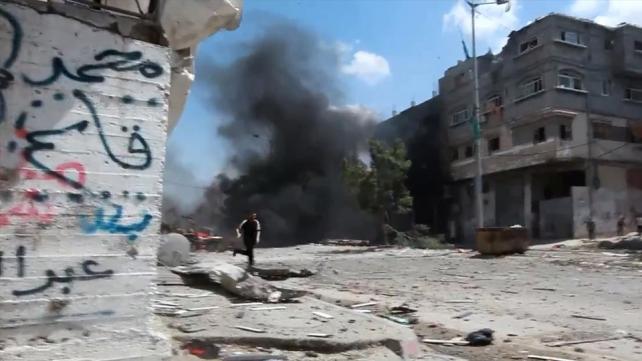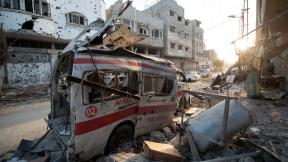
The writer of the Gospel of Mark is a little vague about the numbers.
When reporting on how many people from the Judean countryside came out to see and hear John the baptizer in the wilderness, the writer just says they came from all over the place.
The reportage about those attending from Jerusalem is equally obscure but clearly exaggerated: the reporter claims "all the people of Jerusalem were going out to him, and were baptized by him in the river Jordan, confessing their sins."
Sort of unbelievable.
That isn't the case today in a different part of the Holy Land. The numbers are much more precise.
As of today's date, the latest report, to the United Nations, is 971 Gazans dead, of which 311 are children and 76 are women; 3,100 Gazans reported injured, 1,080 children and 465 women; 60,000 Gazans displaced and all of them in need of help.
That compares with the death of 13 Israelis, 10 of them soldiers and 3 civilians. Four of the Israeli soldiers were the victims of "friendly fire", mistakenly killed, that is, by their own troops.
And since the rationale for Israel's current attack on Gaza by air and on the ground is in retaliation for the rockets fired from Gaza on Israeli civilian population, it is important to have the figures on those attacks during the ceasefire or "lull" from June 19, 2008 (the beginning of the arrangement) through October (soon after which there was a resumption of increased hostilities). The figures for this "lull" period come from official Israeli intelligence sources that are publicly accessible.
During June, 5 rockets and 4 mortar shells were fired from Gaza into Israel. In July the figures were 4 rockets and 8 mortar shells. August brought 8 rockets and 3 mortar shells. September saw 1 rocket and 3 mortar shells. And in October there was 1 rocket and 0 mortar shells. It was a 98% decline during that "lull" period compared to an equivalent time before the ceasefire.
In all of 2008 (prior to, during, and after the "lull") 6 Israelis were killed, which brought the total number of Israeli civilian deaths from rocket and mortar fire to 18 from mid-2004 through the present, and 20 since 2001.
The official Israeli intelligence report, released on November 16, indicated that these rocket and mortar attacks from June through October did not come from Hamas but from "small terrorist groups".
Given the source and specificity, it's all sort of believable.
So is the assessment that, actually, it wasn't Hamas that broke the ceasefire "that put an end to the 'lull'" but the Israelis, who on November 4 bombed Hamas because they thought there was going to be an attempt to abduct some Israeli soldiers. Only then, according again the Israeli intelligence, Hamas re-started sending rockets and mortars into Israel, and even more so when, on November 15, Israel launched an assault on a tunnel that was thought to be used for smuggling arms and ended up killing a number of Palestinians.
Even though the terms of the ceasefire back in June required Israel to open up the blockade into Gaza, a crippling blockade that had been put in place after Hamas won the Palestinian legislative elections in January of 2006 and soon thereafter expelled Fatah, causing great suffering for Gaza's 1.5 million residents, the siege of Gaza didn't lessen during the "lull". Still, Hamas evidently kept its side of the agreement. It wasn't until Israel attacked Gaza militarily in November that Hamas refused to consider an extension of the ceasefire and resumed its attack on Israeli targets.
And now there seems to be believable evidence, reported in the Israeli press, that Israel's Minister of Defense, Ehud Barak, had been making careful and detailed plans since March "three months prior to the beginning of the 'lull'" to invade Gaza at some future time.
One would think Americans would take note of this kind of believable evidence and make some change, even if ever so slightly, in how they view the current conflict.
But, as far as I can tell, that kind of believable change isn't happening.
Yes, this resistance to change can be attributed, to a degree, to an American media that seemingly refuses to alter its "frame" for this on-going saga in the Middle East. And an additional degree or two surely derives from our having politicians too intimidated to entertain rethinking their own positions.
But more than anything else, it appears the American populace may simply be too disinterested or too distracted to engage in believable change on this issue, despite its obvious far-reaching importance not just in the region but across the globe.
Can, therefore, we expect anything different this time around?
The pessimist in me says, "no chance". And I want to avoid the depressing consequences of being an optimist here.
But there is this factor of having a new president of the nation who is moving into the Oval Office by having persuaded people that there is a change to believe in, a change that could make a difference, a change that could alter the ways things have been, and are, and would seem to be intractably.
And then there's that story from the Middle East at the beginning of the Gospel of Mark, the one with all the unbelievable numbers, but with a fairly believable account about change coming from a willingness to acknowledge one's sin and committing oneself to a new way.
Even Jesus comes to the Jordan to be baptized and to present a way for believable change.
We, of course, don't know all that would be involved in a believable change in the Palestinian-Israeli situation, even though there are scenarios that provide us hints. But it's pretty certain that, despite our disinterest and distractions, only death and despair are the continuing consequences of things remaining the same.
So I'm hoping that a new president and an old story can lead us to a change we can believe in a believable change in ourselves and for all those who suffer in that region of the world where our faith has its roots.
By Rev. Larry Greenfield is Executive Minister of American Baptist Churches of Metro Chicago and a leader of Chicago Faith Coalition for Just Peace in the Middle East
"Massacre in Shuja'iyya 20.07.2014.mp4 snapshot 00.02" by moigovps - https://www.youtube.com/watch?v=D28RjX_R1V8. Licensed under Creative Commons Attribution 3.0 via Wikimedia Commons - http://commons.wikimedia.org/wiki/File:Massacre_in_Shuja%27iyya_20.07.2014.mp4_snapshot_00.02.jpg#mediaviewer/File:Massacre_in_Shuja%27iyya_20.07.2014.mp4_snapshot_00.02.jpg




Add new comment